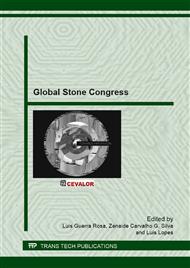p.72
p.82
p.90
p.98
p.106
p.115
p.124
p.135
p.141
Optimisation of Circular Sawing Conditions to Maximize Tool Productivity for each Class of Material
Abstract:
The research disclosed in the present paper reports a new computer algorithm to maximize tool productivity in circular sawing processes, as a function of the stone characteristics and the quality required for the product. This algorithm is currently applied in tool testing at the company FrontWave and will be used in a new type of numeric machine to cut stone, called LeanMachine®. This optimization algorithm essentially depends on three variables: cutting depth, forward speed and rotational speed (identified as the main variables quantifying the sawing process), and how the variables are related with the forces acting on the tool. The algorithm uses the data provided by the relationships between each of the variables and the force acting on the tool (the so-called “force plots”) to determine the optimum working conditions for each tool, aiming to maximize productivity and minimize wear and energy consumption. The algorithm works with different production strategies, involving quality versus productivity, a key factor in the stone industry. A rating is subsequently attributed to each tool, allowing the establishment of tool rankings that can be used as selection criteria by machine operators or automatically in modern cutting stone machines such as LeanMachine®.
Info:
Periodical:
Pages:
106-114
Citation:
Online since:
April 2013
Keywords:
Price:
Сopyright:
© 2013 Trans Tech Publications Ltd. All Rights Reserved
Share:
Citation:


